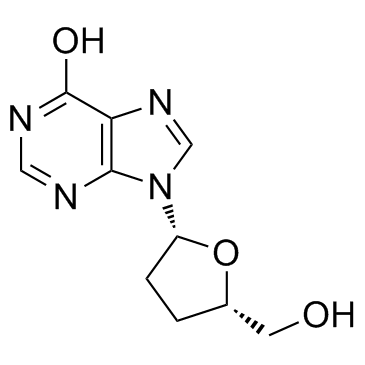2',3'-Dideoxyinosine

2',3'-Dideoxyinosine structure
|
Common Name | 2',3'-Dideoxyinosine | ||
|---|---|---|---|---|
| CAS Number | 69655-05-6 | Molecular Weight | 236.227 | |
| Density | 1.8±0.1 g/cm3 | Boiling Point | 531.2±60.0 °C at 760 mmHg | |
| Molecular Formula | C10H12N4O3 | Melting Point | 193-195 °C | |
| MSDS | Chinese USA | Flash Point | 275.0±32.9 °C | |
|
Absence of a universal mechanism of mitochondrial toxicity by nucleoside analogs.
Antimicrob. Agents Chemother. 51 , 2531-9, (2007) Nucleoside analogs are associated with various mitochondrial toxicities, and it is becoming increasingly difficult to accommodate these differences solely in the context of DNA polymerase gamma inhibition. Therefore, we examined the toxicities of zidovudine (... |
|
|
Cheminformatics analysis of assertions mined from literature that describe drug-induced liver injury in different species.
Chem. Res. Toxicol. 23 , 171-83, (2010) Drug-induced liver injury is one of the main causes of drug attrition. The ability to predict the liver effects of drug candidates from their chemical structures is critical to help guide experimental drug discovery projects toward safer medicines. In this st... |
|
|
Translating clinical findings into knowledge in drug safety evaluation--drug induced liver injury prediction system (DILIps).
J. Sci. Ind. Res. 65(10) , 808, (2006) Drug-induced liver injury (DILI) is a significant concern in drug development due to the poor concordance between preclinical and clinical findings of liver toxicity. We hypothesized that the DILI types (hepatotoxic side effects) seen in the clinic can be tra... |
|
|
Developing structure-activity relationships for the prediction of hepatotoxicity.
Chem. Res. Toxicol. 23 , 1215-22, (2010) Drug-induced liver injury is a major issue of concern and has led to the withdrawal of a significant number of marketed drugs. An understanding of structure-activity relationships (SARs) of chemicals can make a significant contribution to the identification o... |
|
|
A predictive ligand-based Bayesian model for human drug-induced liver injury.
Drug Metab. Dispos. 38 , 2302-8, (2010) Drug-induced liver injury (DILI) is one of the most important reasons for drug development failure at both preapproval and postapproval stages. There has been increased interest in developing predictive in vivo, in vitro, and in silico models to identify comp... |
|
|
FDA-approved drug labeling for the study of drug-induced liver injury.
Drug Discov. Today 16 , 697-703, (2011) Drug-induced liver injury (DILI) is a leading cause of drugs failing during clinical trials and being withdrawn from the market. Comparative analysis of drugs based on their DILI potential is an effective approach to discover key DILI mechanisms and risk fact... |
|
|
Trend analysis of a database of intravenous pharmacokinetic parameters in humans for 670 drug compounds.
Drug Metab. Dispos. 36 , 1385-405, (2008) We present herein a compilation and trend analysis of human i.v. pharmacokinetic data on 670 drugs representing, to our knowledge, the largest publicly available set of human clinical pharmacokinetic data. This data set provides the drug metabolism scientist ... |
|
|
Caenorhabditis elegans as a Model System for Studying Drug Induced Mitochondrial Toxicity.
PLoS ONE 10 , e0126220, (2015) Today HIV-1 infection is recognized as a chronic disease with obligatory lifelong treatment to keep viral titers below detectable levels. The continuous intake of antiretroviral drugs however, leads to severe and even life-threatening side effects, supposedly... |
|
|
Physicochemical determinants of human renal clearance.
J. Med. Chem. 52 , 4844-52, (2009) Kidney plays an important role in the elimination of drugs, especially with low or negligible hepatic clearance. An analysis of the interrelation of physicochemical properties and the human renal clearance for a data set of 391 drugs or compounds tested in hu... |
|
|
Physicochemical space for optimum oral bioavailability: contribution of human intestinal absorption and first-pass elimination.
J. Med. Chem. 53 , 1098-108, (2010) Oral bioavailability (F) is a product of fraction absorbed (Fa), fraction escaping gut-wall elimination (Fg), and fraction escaping hepatic elimination (Fh). In this study, using a database comprised of Fa, Fg, Fh, and F values for 309 drugs in humans, an ana... |